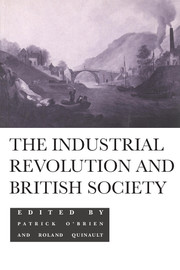Book contents
- Frontmatter
- Contents
- List of contributors
- Preface
- 1 Introduction: Modern conceptions of the Industrial Revolution
- 2 Women in the workforce
- 3 Reinterpretations of the Industrial Revolution
- 4 Religion and political stability in early industrial England
- 5 Sex and desire in the Industrial Revolution
- 6 Political preconditions for the Industrial Revolution
- 7 Crime, law and punishment in the Industrial Revolution
- 8 The Industrial Revolution and parliamentary reform
- 9 Margins of the Industrial Revolution
- 10 Social aspects of the Industrial Revolution
- 11 Technological and organizational change in industry during the Industrial Revolution
- Postscript: An Appreciation of Max Hartwell
- Index
9 - Margins of the Industrial Revolution
Published online by Cambridge University Press: 05 June 2012
- Frontmatter
- Contents
- List of contributors
- Preface
- 1 Introduction: Modern conceptions of the Industrial Revolution
- 2 Women in the workforce
- 3 Reinterpretations of the Industrial Revolution
- 4 Religion and political stability in early industrial England
- 5 Sex and desire in the Industrial Revolution
- 6 Political preconditions for the Industrial Revolution
- 7 Crime, law and punishment in the Industrial Revolution
- 8 The Industrial Revolution and parliamentary reform
- 9 Margins of the Industrial Revolution
- 10 Social aspects of the Industrial Revolution
- 11 Technological and organizational change in industry during the Industrial Revolution
- Postscript: An Appreciation of Max Hartwell
- Index
Summary
Introduction
The cumulative economic advances achieved in the Industrial Revolution required growing and shifting contributions from outlying economies and regions far beyond the recognized centres of industrialization. Manchester, Birmingham, Glasgow, Belfast and Leeds dominated the picture of industrializing Britain. But the Industrial Revolution was also occurring in such places as Wicklow, Montgomeryshire, St Austell, Tiree, King's Lynn, in towns and villages across Europe, and as far away as Australia. Even on the most distant margins of a widening economic world there were visible responses to the broader process. Sometimes reluctantly these places became component parts of the increasingly articulated market system that was intrinsic to the success of British industrialization. Moreover, for the distant and marginal zones of this system, the economic consequences were sometimes even more revolutionary and disruptive than those experienced at the industrial ‘core’.
Regional specialization (in company with other forms of specialization) has been seen by many historians as the engine of economic growth (Pollard 1973). In Britain geographically concentrated production in both agriculture and manufacturing had existed for centuries. But there occurred a clear intensification of regional specialization at the end of the eighteenth century. This tendency could be seen most obviously in the new manufacturing centres which generated disproportionate advances in productivity and the fastest growth in employment.
- Type
- Chapter
- Information
- The Industrial Revolution and British Society , pp. 203 - 228Publisher: Cambridge University PressPrint publication year: 1993
- 3
- Cited by

